
WHILE wandering around in lower Manhattan in 2018, I spotted a rather forbidding-looking building at #102-104 Greenwich, just north of Rector (and one of my favorite lunch joints, George’s Restaurant). A hotel called Riff Downtown could be accessed, probably of the same quality as the late “great” Elk Hotel on 42nd and 9th Avenue.
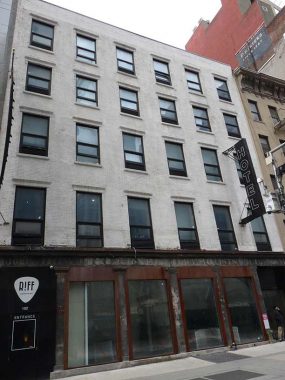
But that’s not what attracted my attention. Above the first floor, in lettering that appeared to be from the 19th Century, read: “102 Bowli [unintelligible] Warehousing Co. Inc. 104.”
I had thought it was associated with the Bowne family:
The Bowne name is well-known in NYC. John Bowne House, on Bowne Street north of 38th Avenue in Flushing, Queens, was built in 1661 by English settler John Bowne and, unlike many other colonial houses from the 17th and 18th centuries, it still looks a great deal like it did when it was built.
Peter Stuyvesant, continuing his reign of terror against religious dissenters, had Bowne, a Quaker, arrested in 1662. Before the construction of the Friends Meetinghouse on Northern Boulevard, Bowne’s house was the primary site for Quaker services. Sentenced to pay a hefty fine, Bowne refused and was jailed; he was subsequently exiled to Holland. While he was there, Stuyvesant’s bosses at the Dutch West India Company reversed Stuyvesant’s non-tolerant policy, claiming that the colony needed many immigrants to ensure economic expansion, no matter what faith they were. Bowne returned home to Flushing in 1664; the British sailed into New Netherland five months later, and Stuyvesant surrendered without a shot being fired.
Bowne’s illustrious descendants included Robert Bowne, who founded the still-extant Bowne & Co. financial printers; Walter Bowne, NYC mayor from 1829-1833; shipping magnate Robert Bowne Minturn; and abolitionist Mary Bowne Parsons, wife of horticulturalist Samuel Parsons, who may have used the Bowne House as an underground railroad way station.
Bowne & Co. Stationers at 211 Water Street, at the South Street Seaport, is a working job print shop as well as a department of the South Street Seaport Museum. It was one of the first preservation projects undertaken by the Museum in 1975.
Two hundred years before, a dry goods store called Bowne & Company had opened, and it later focused on printing, especially financial documents like prospectuses and merger proxies. One of its customers was Lehman Brothers, the investment bank that collapsed in 2008. Today, Bowne Printers still works in handset type, as was done 200 years ago. The Bowne family has far flung holdings in the NYC area. Other Bownes settled in City Island, an island in Eastchester Bay part of New York City since 1895, and there, Bowne Street recollects their presence.
Meanwhile there’s a Bowne Street in Brooklyn, in Red Hook. According to Benardo & Weiss’ Brooklyn By Name, that Bowne Street is named for brothers Rodman and Samuel, who ran a ferry from Red Hook to Catherine Street in Manhattan beginning in 1811. Walter Bowne (1770-1846), served as NYC mayor from 1828-1832. Walter Bowne’s summer residence stood on the site of Bowne Park in Flushing until it burned down in 1925 and the City acquired the property for parkland.
Bowne was in office during a cholera epidemic and in 1832 established a strict quarantine restricting travel in and out of the city which at that point consisted of just Manhattan island, in a situation that reminds us of the current situation with Covid-19. Bowne, and others at the time, were unaware that cholera is not contagious and only much later, in 1883, was it discovered that cholera is spread through contaminated water or food. Despite his efforts cholera killed hundreds of New Yorkers.
However: This was the Bowling Green Warehousing Co. according to Historic Districts Council.
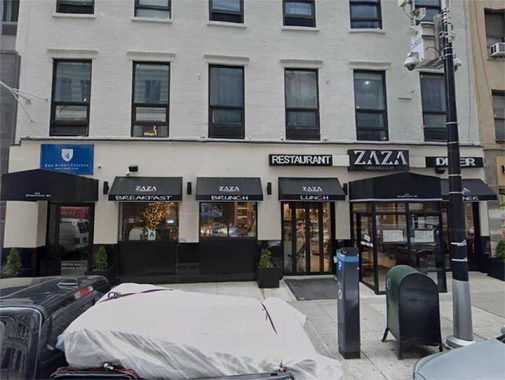
By 2022, the sign had vanished as the building now hosts a restaurant called Zaza on the ground floor and King’s College dorms on the upper floors.
As always, “comment…as you see fit.” I earn a small payment when you click on any ad on the site.
6/1/23

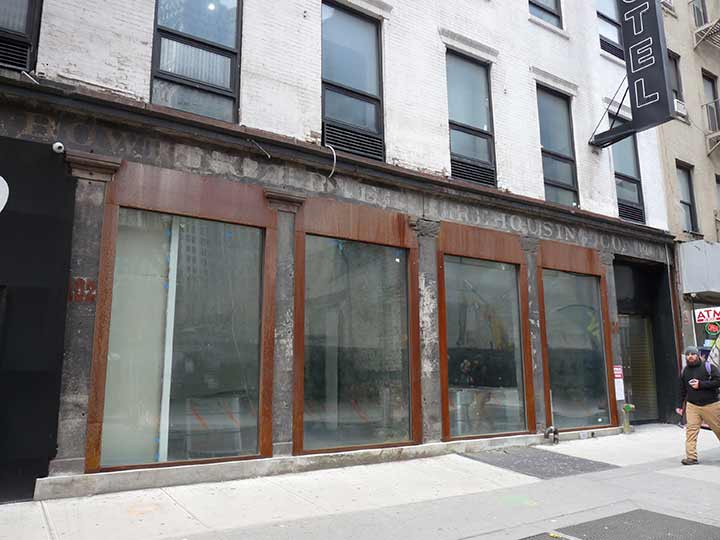
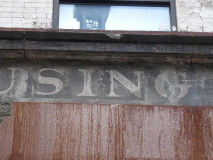
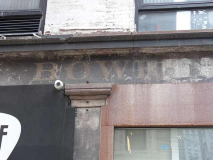
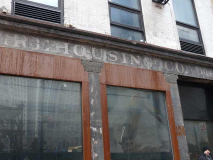
7 comments
Riff Hotel wasn’t a hot sheets operation. It was a budget hotel aimed at 20-somethings and having a rock music theme. There was (is) another one in Chelsea. King’s College bought it for a woman’s dorm and named it DeVos Hall, Betsy DeVos’s inland being huge donors to the school (also supported by Rebekah Mercer; Dinesh D’Souza was a former president). The dorm has been emptied out and King’s College is in a death spiral. There was an adult bookstore there in the early aughts. Wonder what is up next for the building. It was shameful for the college to cover up the old sign. However mediocre Riff was as a neighbor, they did good in saving the sign.
will amend
Hark! Theres a sign above the building on a wall.Having trouble reading it
barely legible….too early to say to be sure…can make out the letters P and R
but thats about it….could it be for Bowne? should it be for Bowne?
Somewhere in the late 1950’s, my grandfather took me to the Bowne House for a docent-led tour. (Even as a small boy I had a penchant for all things historical.) Among the things that I still remember, two particularly stand out. The first was being shown a trap door in the floor, which was covered by a rug. We were told that it was likely a hiding place on the Underground Railroad. That was my first exposure to a conversation on Slavery. The second was how my Italian-born grandfather laughed when the docent said that the Bowne House was ancient. He told her that the house in which he was born was the same age and that may other buildings in his village were much older. That was my first exposure to historical “relativity” – something that, at 300 years old, was ancient in one place, but was commonplace in another.
I thought it was my old, aging eyes at first. I didn’t see “Bowne” on that sign. I wasn’t sure what I saw, but I didn’t see a “N” as the fourth letter The Historic Districts Council apparently didn’t see it either: Bowling Green Warehousing Co.
All the Bowne stuff is interesting, of course, but I’m not seeing Bowne on the building’s signage. Maybe it’s just my old and ever-aging eyes, but I’m not seeing an “N” as the fourth letter. The Historic Districts Council apparently didn’t either: Bowling Green Warehousing Co..
In 1854 a British doctor named John Snow conducted one of the first epidemiological studies and found out that most victims of a major cholera outbreak in London had drunk water from a single public well. He persuaded officials to remove the handle from the well’s pump and the outbreak soon ended. In 1883 German doctor Robert Koch determined the bacterial origins of the disease.